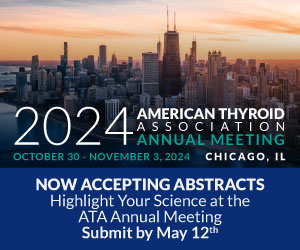October 28, 2014 — The prevalence of papillary thyroid carcinoma (PTC), the most common type of thyroid cancer, is increasing rapidly. New research to determine the impact of radioactive iodine (RAI) therapy on survival in PTC, describing a novel blood test able to detect circulating BRAFV600E-positive tumor DNA, and identifying a long non-coding RNA specifically associated with the thyroid that is down-regulated in PTC compared to normal thyroid tissue in patient-derived clinical specimens and cell cultures will be featured in oral presentations delivered at the 84th Annual Meeting of the American Thyroid Association, October 29-November 2, 2014, in Coronado, California.
In the presentation “Impact of Radioactive Iodine on Survival in Papillary Thyroid Carcinoma,” Paritosh Suman, M.D. and colleagues from North Shore University Health System (Evanston, IL), explore the benefit of (RAI) treatment following surgery to remove the thyroid in patients with PTC, and whether survival benefit relates to tumor size. In a retrospective study of nearly 285,000 patients treated over 13 years, with a mean follow-up of 7 years, the authors found that 47% of patients had RAI therapy and it showed a small but statistically significant survival benefit regardless of the tumor size.
Carrie Lubitz, M.D., M.P.H., Massachusetts General Hospital (Boston), and coauthors previously described a novel blood-based assay for detecting the V600E mutation in the BRAF gene in patients with melanoma. The BRAFV600E mutation is the most common genetic alteration in patients with PTC and is associated with a poorer prognosis, higher risk of metastasis and mortality, and resistance to RAI therapy. In the presentation “Detection of Circulating BRAFV600E in Patients with Papillary Thyroid Carcinoma,” Lubitz et al. used the assay to measure circulating BRAFV600E levels in blood samples from patients with PTC and compared the results to conventional BRAFV600E assays. Circulating BRAFV600E levels were detectable in the blood of PTC patients, suggesting the feasibility of using the assay for diagnosis, post-operative surveillance, and to monitor treatment response to BRAF inhibitors.
Carmelo Nucera, M.D., Ph.D., Harvard Medical School and Beth Israel Deaconess Medical Center (Boston, MA) and colleagues discovered a large non-coding RNA (LincRNA) neighboring the thyroid peroxidase (TPO) gene that is present in significantly lower numbers in BRAFV600E-positive PTC tissue samples than in normal thyroid tissue. The LincRNA is specifically associated with thyroid tissue compared to other human tissues or cell types. The authors propose that the LincRNA might have an important role in regulating iodine metabolism associated gene expression and could serve as a biomarker for monitoring patients undergoing targeted therapies and for early diagnosis of BRAFV600E-PTC. They describe their findings in the presentation “Identification of Iodine Metabolism-Associated Large Non-coding RNA (LincRNA) Differentially Expressed in BRAFV600E-postivie Papillary Thyroid Cancer Versus Normal Thyroid Tissue.”
“The identification of new circulating markers, if validated, should improve both the diagnosis and longitudinal follow-up of patients with papillary thyroid cancer,” says Robert C. Smallridge, M.D. President Elect of the ATA.
###
The American Thyroid Association (ATA) is the leading worldwide organization dedicated to the advancement, understanding, prevention, diagnosis, and treatment of thyroid disorders and thyroid cancer. ATA is an international membership medical society with over 1,700 members from 43 countries around the world. Celebrating its 91st anniversary, the ATA delivers its mission — of being devoted to thyroid biology and to the prevention and treatment of thyroid disease through excellence in research, clinical care, education, and public health — through several key endeavors: the publication of highly regarded professional journals, Thyroid, Clinical Thyroidology, and VideoEndocrinology; annual scientific meetings; biennial clinical and research symposia; research grant programs for young investigators, support of online professional, public and patient educational programs; and the development of guidelines for clinical management of thyroid disease and thyroid cancer. The ATA promotes thyroid awareness and information through its online Clinical Thyroidology for the Public (distributed free of charge to over 11,000 patients and public subscribers) and extensive, authoritative explanations of thyroid disease and thyroid cancer in both English and Spanish. The ATA website serves as the clinical resource for patients and the public who look for reliable information on the Internet.



